16 febbraio – 4 maggio 2025
Scrolldown English version.
In un’anteprima mondiale la Fondation Beyeler propone una selezione rappresentativa di capolavori surrealisti della Collection Hersaint. La mostra comprende circa 50 opere chiave di artiste e artisti quali Salvador Dalí, Max Ernst, René Magritte, Joan Miró, Pablo Picasso, Man Ray, Dorothea Tanning, Toyen, Balthus, Jean Dubuffet, Wifredo Lam e altri ancora. I soggetti delle opere toccano temi centrali del surrealismo come la notte, il sogno, l’inconscio, la metamorfosi o il bosco visto come luogo del mistero. I dipinti della Collection Hersaint sono posti in dialogo con importanti opere della Fondation Beyeler.

Oil on canvas, 114 x 146 cm
Collection Hersaint
© 2024, ProLitteris, Zurich
Photo: Peter Schälchli, Zurich.
«La chiave dei sogni», questo il titolo di uno dei capolavori di René Magritte nella raccolta, è un’opera emblematica che dà il tono a tutta la Collection Hersaint, con i suoi ripetuti riferimenti al mondo misterioso e inquietante dei sogni e dell’inconscio. La collezione fu iniziata da Claude Hersaint (1904; San Paolo – 1993; Crans-Montana), uno dei primi e maggiori estimatori del surrealismo. Cresciuto in Brasile e in seguito trasferitosi a Parigi, nel 1921, all’età di soli 17 anni, acquistò il suo primo quadro di Max Ernst. Da qui nacque in lui una passione per l’arte che durò tutta la vita e che sfociò in una delle più prestigiose collezioni di pittura surrealista. Oggi la Collection Hersaint conta circa 150 opere, tra cui uno dei più cospicui nuclei di dipinti di Max Ernst in mano privata. Per tutta la vita Claude Hersaint fu in rapporti d’amicizia con artiste e artisti che sostenne generosamente. Il suo entusiasmo e il suo impegno per l’arte si trasmisero anche alla moglie Françoise e alla figlia Evangéline.
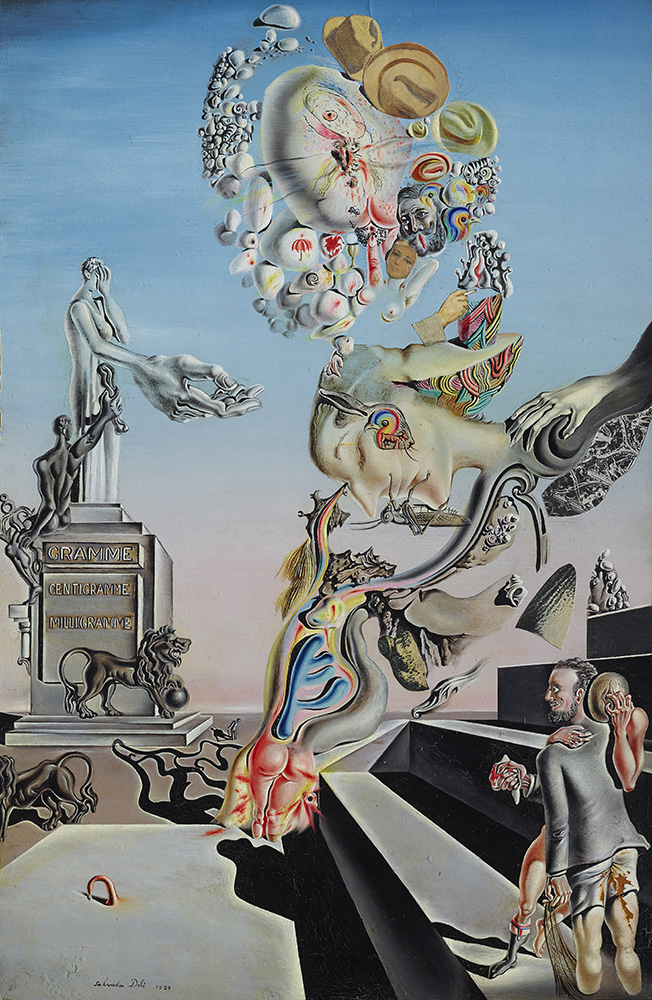
Oil and collage on cardboard, 44.4 x 30.3 cm
Collection Hersaint
© 2025 Fundació Gala-Salvador Dalí / ProLitteris, Zurich
Photo: Peter Schälchli, Zurich.
Tra le numerose opere significative della Collection Hersaint si trova anche l’espressivo dipinto di Max Ernst L’angelo del focolare (Il trionfo del surrealismo) del 1937, assurto a icona assoluta del surrealismo. Enigmatico e abissale, Il gioco lugubre (1929) di Salvador Dalí riflette la quintessenza dell’arte di Dalí e la sua attrazione per i tabù erotici e psicologici. Con Passage du Commerce-Saint-André (1952-1954), si può ammirare il monumentale capolavoro di Balthus, da lungo tempo in prestito permanente alla Fondation Beyeler. Notevole è anche la presenza di due esponenti femminili del surrealismo, Dorothea Tanning e Toyen, con le loro particolarissime opere praticamente mai esposte in pubblico prima d’ora.
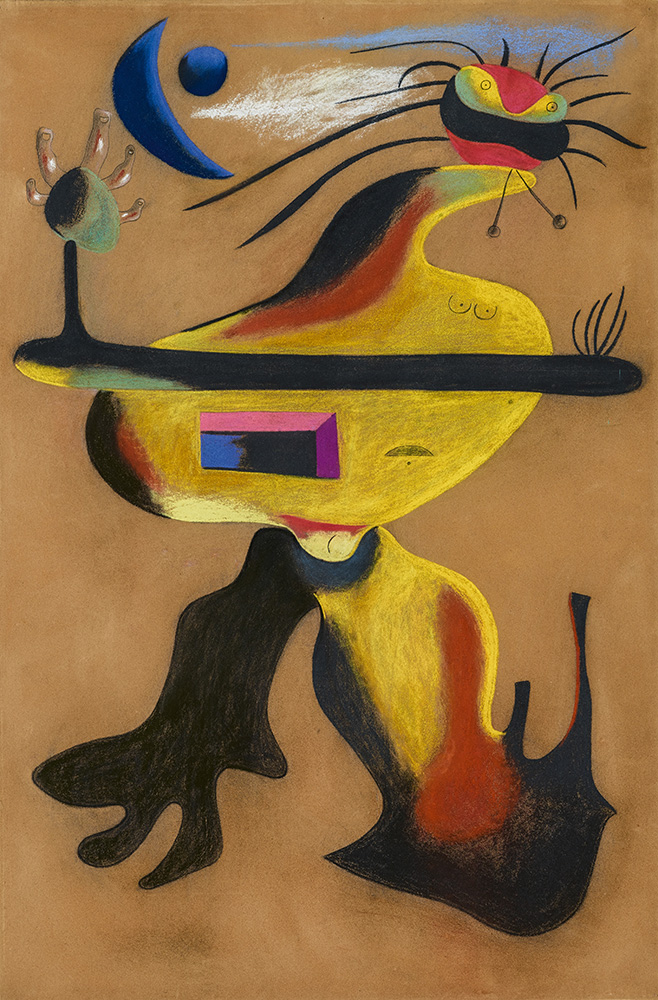
Pastel on velours paper, 106.5 x 70.5 cm
Collection Hersaint
© 2025 Successió Miró / ProLitteris, Zurich
Photo: Peter Schälchli, Zurich.
Una lunga amicizia legò Claude, Françoise ed Evangéline Hersaint a Ernst e Hildy Beyeler. La Collezione Beyeler e la Collection Hersaint evidenziano analogie e differenze e per questo si completano idealmente a vicenda. I richiami all’arte surrealista palesi nella Collezione Beyeler emergono ancora più chiaramente dal confronto dialogico con la Collection Hersaint. Nel loro molteplice e fruttuoso interagire le due raccolte dispiegano un grande potenziale. In tale prospettiva i capolavori della Collection Hersaint sono esposti fianco a fianco a opere di artisti in collezione alla Fondation Beyeler, ad esempio Louise Bourgeois, Jean Dubuffet, Max Ernst, Alberto Giacometti, Joan Miró, Pablo Picasso e Henri Rousseau.
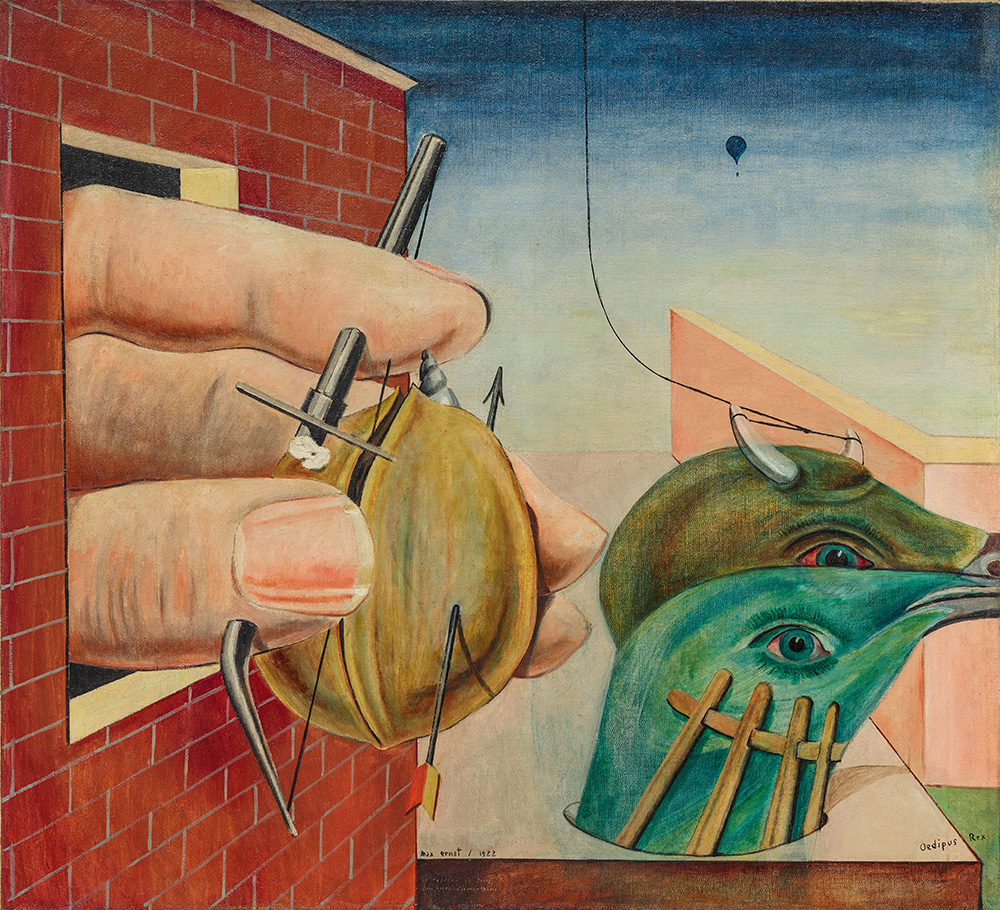
Oil on canvas, 93 x 102 cm
Collection Hersaint
© 2025 ProLitteris, Zurich
Photo: Peter Schälchli, Zurich.
Claude Hersaint naque nel 1904 a San Paolo, in Brasile, dove la sua famiglia originaria dell’Alsazia-Lorena era emigrata a metà Ottocento. Cresciuto in un ambiente tradizionale dell’alta borghesia colta, da giovane si trasferì a Parigi per frequentare scienze politiche e studiare legge. Claude Hersaint lavorò in seguito come banchiere, professione che svolse per il resto della sua vita. Nella capitale francese fece amicizia con importanti artisti surrealisti quali Max Ernst, Victor Brauner e Óscar Domínguez, oltre che con Balthus e Jean Dubuffet. Claude Hersaint fu anche amico di influenti scrittori, intellettuali e collezionisti come Jacques Lacan, Georges Bataille, Jean Paulhan e Marie-Laure de Noailles. Nel 1938 sposò in prime nozze Hélène Anavi, una personalità mondana e brillante del suo tempo. A causa della seconda guerra mondiale e delle persecuzioni naziste Claude Hersaint e Hélène Anavi lasciarono precipitosamente Parigi all’inizio del 1942. Dopo essere fuggiti dapprima a Rio de Janeiro, emigrarono poi a New York. Lì conobbero Robert Oppenheimer, Claude Lévi-Strauss, Leo Castelli, Pierre Matisse, Man Ray, Dorothea Tanning e molti altri artisti andati in esilio durante la guerra.
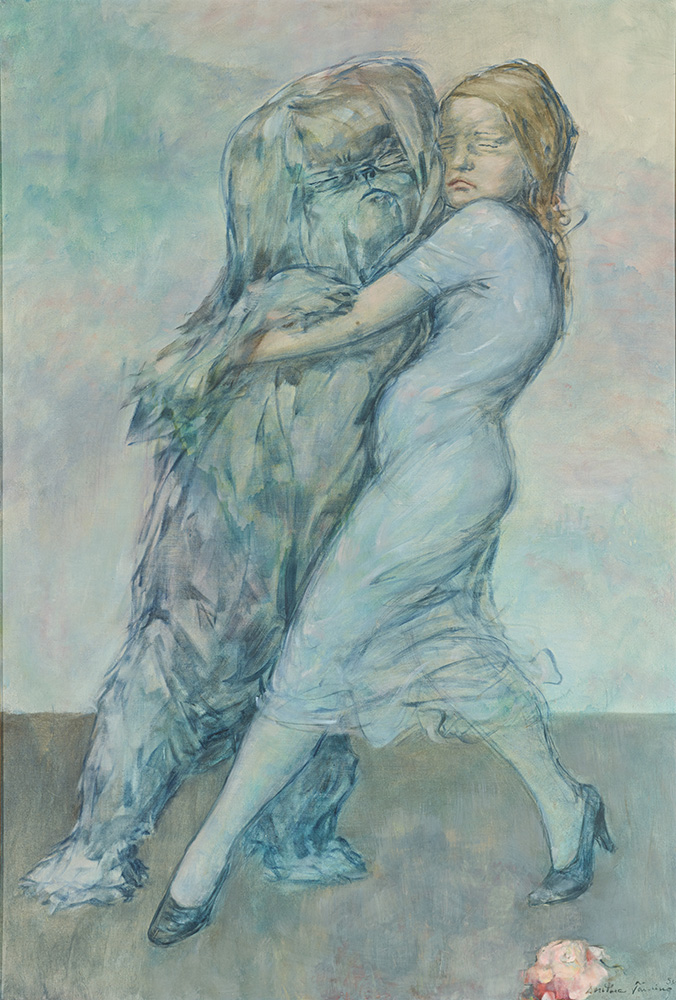
Oil on canvas, 130 x 97 cm
Collection Hersaint
© 2025 ProLitteris, Zurich
Photo: Peter Schälchli, Zurich.
Dopo il secondo conflitto mondiale Claude Hersaint tornò a Parigi, dove incontrò colei che sarebbe diventata la sua seconda moglie, Françoise Moutier. Dal 1948 Claude Hersaint e Françoise Hersaint vissero a Montreux e a Parigi, fino a quando si stabilirono a Crans-Montana, in Vallese. Dopo la morte del marito, Françoise Hersaint si occupò a fondo della raccolta. Oggi la figlia Evangéline Hersaint continua a gestire la Collection Hersaint e la apre per la prima volta al pubblico con questa mostra.
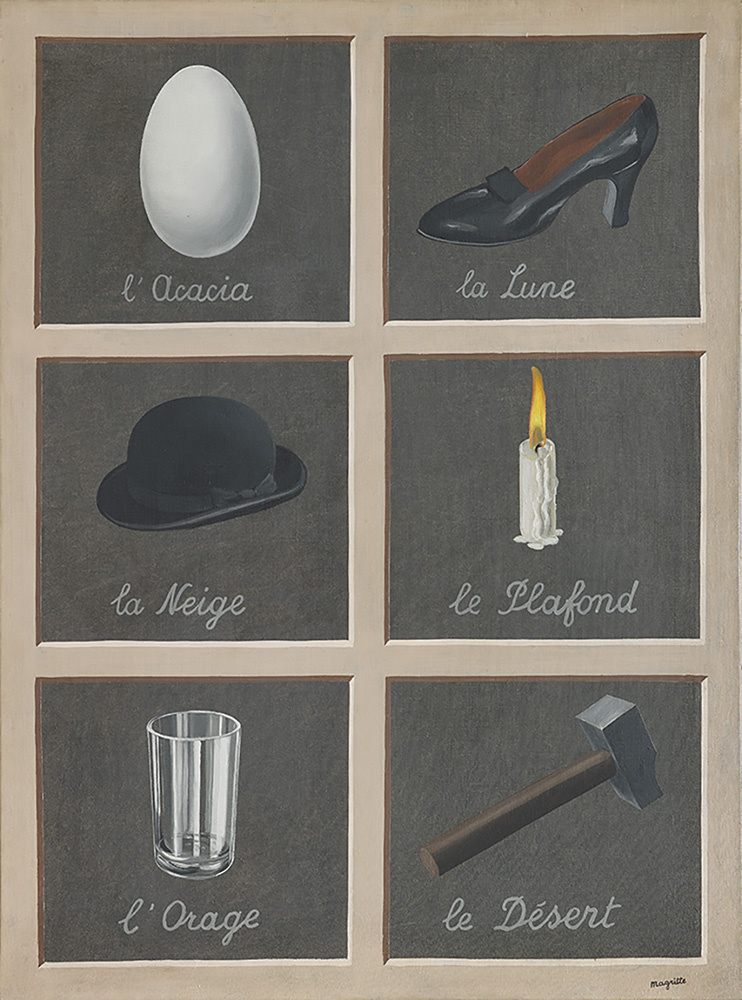
Oil on canvas, 81 x 60 cm
Collection Hersaint
© 2025 ProLitteris, Zurich
Photo: Peter Schälchli, Zurich.
«La chiave dei sogni. Capolavori surrealisti della Collection Hersaint» è realizzata grazie al generoso sostegno di Evangéline Hersaint e Laetitia Hersaint-Lair. La curatela della mostra è affidata al dr. Raphaël Bouvier, Senior Curator della Fondation Beyeler.
Accompagna la mostra un catalogo riccamente illustrato a cura di Raphaël Bouvier per la Fondation Beyeler, realizzato da Uwe Koch e Silke Fahnert e pubblicato in tedesco e in francese da Hatje Cantz Verlag, Berlino. Il volume di 152 pagine contiene una prefazione introduttiva e riporta un’ampia conversazione con la collezionista Evangéline Hersaint.
La mostra è generosamente sostenuta da:
Beyeler-Stiftung
Hansjörg Wyss, Wyss Foundation
Fondation Beyeler
La Fondation Beyeler di Riehen presso Basilea è internazionalmente rinomata per le sue mostre di altissima levatura, per la sua importante collezione di arte moderna e contemporanea e per il suo ambizioso programma di eventi. L’edificio del museo in un idilliaco parco punteggiato di alberi secolari e stagni di ninfee è opera dell’architetto Renzo Piano. La sua posizione nel mezzo di una zona ricreativa con vista su campi di grano, mucche al pascolo e vigneti ai piedi della Foresta Nera è unica. Nel parco adiacente la Fondation Beyeler sta realizzando un nuovo edificio museale con l’architetto svizzero Peter Zumthor, rafforzando così il legame armonioso tra arte, architettura e natura.
Ulteriori informazioni:
Dorothee Dines
Responsabile PR & Media Relations
Tel. +41 (0)61 645 97 21, presse@fondationbeyeler.ch, www.fondationbeyeler.ch
Fondation Beyeler, Beyeler Museum AG, Baselstrasse 77, CH-4125 Riehen
Orari di apertura della Fondation Beyeler: tutti i giorni ore 10–18, mercoledì fino alle ore 20
The Key to Dreams.
Surrealist Masterworks from the Collection Hersaint
16 February – 4 May 2025
In a world premiere, the Fondation Beyeler is showing a representative selection of surrealist masterpieces from the Hersaint Collection. The exhibition includes around 50 key works by artists such as Salvador Dalí, Max Ernst, René Magritte, Joan Miró, Pablo Picasso, Man Ray, Dorothea Tanning, Toyen as well as Balthus, Jean Dubuffet, Wifredo Lam and many others, reflecting on major themes of Surrealism such as the night, dreams, the unconscious, metamorphoses or the forest as a site of mystery. The paintings from the Hersaint Collection are presented in dialogue with important works from the Fondation Beyeler.
Referencing the title of a major work by René Magritte from the Hersaint Collection, “The Key to Dreams” encapsulates the surrealist focus of the collection with its numerous references to the mysterious and uncanny world of dreams, nightmares and the unconscious. The Hersaint Collection was founded by Claude Hersaint (1904, São Paulo – 1993, Crans-Montana), one of the earliest and most important collectors of Surrealist art. Growing up in Brazil, he later moved to Paris, where he acquired his first painting by Max Ernst in 1921 at the age of 17. A life-long passion for art evolved, resulting in one of the most remarkable collections of surrealist painting. Today, the Hersaint Collection comprises around 150 works, including one of the most important private collections of works by Max Ernst. Throughout his life, Claude Hersaint was friends with many artists and supported them significantly. His enthusiasm and commitment to art extended to his wife Françoise Hersaint and his daughter Evangéline Hersaint.
Among the numerous masterpieces in the collection is Max Ernst’s impressive The Fireside Angel (The Triumph of Surrealism) from 1937, which has become an icon of Surrealism in its own right. Salvador Dalí’s enigmatic and mysterious painting The Lugubrious Game from 1929 epitomises the quintessence of his art with its focus on erotic and psychological taboos. Also on display is Balthus’ Passage du Commerce-Saint-André (1952-1954), the artist’s monumental masterpiece, which has been on permanent loan to the Fondation Beyeler for many years. Dorothea Tanning and Toyen, two key Surrealists, are also represented with characteristic works that have hardly ever been shown in public before.
Claude, Françoise and Evangéline Hersaint maintained a lasting friendship with Ernst and Hildy Beyeler. While the collection of the Fondation Beyeler and the Collection Hersaint exhibit both similarities and differences, they complement each other in an ideal way. In dialogue with the Collection Hersaint, the references to surrealist art in the Beyeler Collection are brought to light, becoming particularly evident in the encounter with paintings by Louise Bourgeois, Jean Dubuffet, Max Ernst, Alberto Giacometti, Joan Miró, Pablo Picasso and Henri Rousseau from the collection of the Fondation Beyeler.
Claude Hersaint was born in 1904 in São Paulo, where his family, originally from Alsace-Lorraine, had emigrated to in the mid-19th century. He grew up in the traditional milieu of the intellectual upper class and moved to Paris as a young man, where he attended “Sciences Po” and studied law. Claude Hersaint went on to work in banking, a profession he pursued for the rest of his life. In Paris, he became close friends with important surrealist artists such as Max Ernst, Victor Brauner and Óscar Domínguez, as well as with Balthus and Jean Dubuffet. Claude Hersaint was also friends with influential writers, intellectuals and collectors such as Jacques Lacan, Georges Bataille, Jean Paulhan and Marie-Laure de Noailles. In 1938, he married his first wife Hélène Anavi, a flamboyant personality of her time. Due to the Second World War and persecution by the Nazis, Claude Hersaint and Hélène Anavi fled Paris at the beginning of 1942. After first leaving for Rio de Janeiro, they immigrated to New York. There they became friends with Robert Oppenheimer, Claude Lévi-Strauss, Leo Castelli and Pierre Matisse as well as Man Ray, Dorothea Tanning and numerous artists who had gone into exile during the war.
After the Second World War, Claude Hersaint returned to Paris, where he met his second wife, Françoise Moutier. Claude Hersaint and Françoise Hersaint then lived in Montreux and Paris until they finally settled in Crans-Montana in the Valais. After her husband’s death, Françoise Hersaint was heavily committed to the collection. Today, their daughter Evangéline Hersaint carries on the Hersaint Collection and is making it accessible to the general public for the first time with this exhibition.
“The Key to Dreams. Surrealist Masterpieces from the Collection Hersaint” has been made possible by the generous support of Evangéline and Laetitia Hersaint-Lair. The exhibition is curated by Dr Raphaël Bouvier, Senior Curator of the Fondation Beyeler.
A richly illustrated catalogue in German and French, edited by Raphaël Bouvier for the Fondation Beyeler and designed by Uwe Koch and Silke Fahnert, is published by Hatje Cantz Verlag, Berlin, to accompany the exhibition. It comprises 152 pages and contains an introductory foreword and an in-depth conversation with the collector Evangéline Hersaint.
The exhibition is generously supported by:
Beyeler-Stiftung
Hansjörg Wyss, Wyss Foundation
Fondation Beyeler
The Fondation Beyeler in Riehen near Basel is internationally renowned for its high-calibre exhibitions, its major collection of modern and contemporary art, as well as its ambitious schedule of events. The museum building was designed by Renzo Piano in the idyllic setting of a park with venerable trees and water lily ponds. It boasts a unique location in the heart of a local recreation area, looking out onto fields, pastures and vineyards close to the foothills of the Black Forest. In collaboration with Swiss architect Peter Zumthor, the Fondation Beyeler is constructing a new museum building in the adjoining park, thus further enhancing the harmonious interplay of art, architecture and nature.
Further information:
Dorothee Dines
Head of PR & Media Relations
Tel. + 41 (0)61 645 97 21, presse@fondationbeyeler.ch, www.fondationbeyeler.ch
Fondation Beyeler, Beyeler Museum AG, Baselstrasse 77, CH-4125 Riehen, Switzerland
Fondation Beyeler opening hours: 10am to 6pm daily, Wednesday 10am to 8pm
